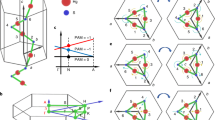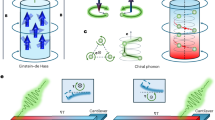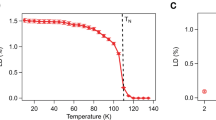Abstract
A rapidly increasing body of work reporting phenomena associated with lattice vibrations carrying angular momentum has led to the emergence of the field of chiral phonons. Some of these properties, such as the phonon magnetic moment, also occur in achiral phonons that are circularly or elliptically polarized, while the presence of chirality has additional implications for the types of interaction allowed between the phonons and light, electrons and other quasiparticles. In this Perspective we introduce a framework for classifying phonons with angular momentum, and provide illustrations of the different types using examples from the recent literature. Specifically, we suggest the term ‘axial phonon’ to encompass all phonons that carry angular momentum, real or pseudo, and reserve the term ‘chiral phonon’ for those phonons that break improper rotational symmetry. We hope that this scheme provides clarification on the matter of phonon chirality and will serve as a guide for future research.
This is a preview of subscription content, access via your institution
Access options
Access Nature and 54 other Nature Portfolio journals
Get Nature+, our best-value online-access subscription
$32.99 / 30 days
cancel any time
Subscribe to this journal
Receive 12 print issues and online access
$259.00 per year
only $21.58 per issue
Buy this article
- Purchase on SpringerLink
- Instant access to full article PDF
Prices may be subject to local taxes which are calculated during checkout




Similar content being viewed by others
References
Zhang, L. & Niu, Q. Chiral phonons at high-symmetry points in monolayer hexagonal lattices. Phys. Rev. Lett. 115, 115502 (2015).
Zhu, H. et al. Observation of chiral phonons. Science 359, 579–582 (2018).
Grissonnanche, G. et al. Giant thermal Hall conductivity in the pseudogap phase of cuprate superconductors. Nature 571, 376–380 (2019).
Grissonnanche, G. et al. Chiral phonons in the pseudogap phase of cuprates. Nat. Phys. 16, 1108–1111 (2020).
Li, X., Fauqué, B., Zhu, Z. & Behnia, K. Phonon thermal Hall effect in strontium titanate. Phys. Rev. Lett. 124, 105901 (2020).
Juraschek, D. M., Fechner, M., Balatsky, A. V. & Spaldin, N. A. Dynamical multiferroicity. Phys. Rev. Mater. 1, 014401 (2017).
Cheng, B. et al. A large effective phonon magnetic moment in a Dirac semimetal. Nano Lett. 20, 5991–5996 (2020).
Baydin, A. et al. Magnetic control of soft chiral phonons in PbTe. Phys. Rev. Lett. 128, 075901 (2022).
Hernandez, F. G. G. et al. Observation of interplay between phonon chirality and electronic band topology. Sci. Adv. 9, eadj407 (2023).
Mustafa, H. et al. Origin of large effective phonon magnetic moments in monolayer MoS2. ACS Nano 19, 11241–11248 (2025).
Wu, F. et al. Fluctuation-enhanced phonon magnetic moments in a polar antiferromagnet. Nat. Phys. 19, 1868–1875 (2023).
Lujan, D. et al. Spin–orbit exciton-induced phonon chirality in a quantum magnet. Proc. Natl Acad. Sci. USA 121, e2304360121 (2024).
Mai, T. T. et al. Spin-orbital–lattice coupling and the phonon Zeeman effect in the Dirac honeycomb magnet CoTiO3. Phys. Rev. B 111, 104419 (2025).
Chen, L. et al. Planar thermal Hall effect from phonons in a Kitaev candidate material. Nat. Commun. 15, 3513 (2024).
Che, M. et al. Magnetic order induced chiral phonons in a ferromagnetic Weyl semimetal. Phys. Rev. Lett. 134, 196906 (2025).
Zhang, L. & Niu, Q. Angular momentum of phonons and the Einstein–de Haas Effect. Phys. Rev. Lett. 112, 085503 (2014).
Dornes, C. et al. The ultrafast Einstein-de Haas effect. Nature 565, 209–212 (2019).
Tauchert, S. R. et al. Polarized phonons carry angular momentum in ultrafast demagnetization. Nature 602, 73–77 (2022).
Choi, I. H. et al. Real-time dynamics of angular momentum transfer from spin to acoustic chiral phonon in oxide heterostructures. Nat. Nanotechnol. 19, 1277–1282 (2024).
Nova, T. F. et al. An effective magnetic field from optically driven phonons. Nat. Phys. 13, 132–136 (2017).
Juraschek, D. M., Narang, P. & Spaldin, N. A. Phono-magnetic analogs to opto-magnetic effects. Phys. Rev. Res. 2, 043035 (2020).
Juraschek, D. M., Neuman, T. & Narang, P. Giant effective magnetic fields from optically driven chiral phonons in 4f paramagnets. Phys. Rev. Res. 4, 013129 (2022).
Geilhufe, R. M., Juričić, V., Bonetti, S., Zhu, J.-X. & Balatsky, A. V. Dynamically induced magnetism in KTaO3. Phys. Rev. Res. 3, L022011 (2021).
Luo, J. et al. Large effective magnetic fields from chiral phonons in rare-earth halides. Science 382, 698–702 (2023).
Basini, M. et al. Terahertz electric-field-driven dynamical multiferroicity in SrTiO3. Nature 628, 534–539 (2024).
Davies, C. S. et al. Phononic switching of magnetization by the ultrafast Barnett effect. Nature 628, 540–544 (2024).
Ishito, K. et al. Truly chiral phonons in α-HgS. Nat. Phys. 19, 35–39 (2023).
Ishito, K. et al. Chiral phonons: circularly polarized Raman spectroscopy and ab initio calculations in a chiral crystal tellurium. Chirality 35, 338–345 (2023).
Ueda, H. et al. Chiral phonons in quartz probed by X-rays. Nature 618, 946–950 (2023).
Romao, C. P. & Juraschek, D. M. Phonon-induced geometric chirality. ACS Nano 18, 29550–29557 (2024).
Barron, L. D. Molecular Light Scattering and Optical Activity 2nd edn (Cambridge Univ. Press, 2004).
Coh, S. Classification of materials with phonon angular momentum and microscopic origin of angular momentum. Phys. Rev. B 108, 134307 (2023).
Zhang, T. & Murakami, S. Chiral phonons and pseudoangular momentum in nonsymmorphic systems. Phys. Rev. Res. 4, L012024 (2022).
Zhang, S. et al. Comprehensive study of phonon chirality under symmetry constraints. Preprint at https://arxiv.org/abs/2503.22794 (2025).
Fava, M., McCabe, E., Romero, A. H. & Bousquet, E. Phonon-driven mechanism for the chiral phase transition of K3NiO2. Phys. Rev. B 111, 174102 (2025).
Zhang, S., Luo, K. & Zhang, T. Understanding chiral charge-density wave by frozen chiral phonon. npj Comput. Mater. 10, 264 (2024).
Zeng, Z. et al. Photo-induced chirality in a non-chiral crystal. Science 387, 431–436 (2025).
Inda, A., Oiwa, R., Hayami, S., Yamamoto, H. M. & Kusunose, H. Quantification of chirality based on electric toroidal monopole. J. Chem. Phys. 160, 184117 (2024).
Rostami, H., Guinea, F. & Cappelluti, E. Strain-driven chiral phonons in two-dimensional hexagonal materials. Phys. Rev. B 105, 195431 (2022).
Cappelluti, E., Silva-Guillén, J. A., Rostami, H. & Guinea, F. Flat-band optical phonons in twisted bilayer graphene. Phys. Rev. B 108, 125401 (2023).
Parlak, S., Ghosh, S. & Garate, I. Detection of phonon helicity in nonchiral crystals with Raman scattering. Phys. Rev. B 107, 104308 (2023).
Boulanger, M.-E. et al. Thermal Hall conductivity in the cuprate Mott insulators Nd2CuO4 and Sr2CuO2Cl2. Nat. Commun. 11, 5325 (2020).
Flebus, B. & MacDonald, A. H. Charged defects and phonon Hall effects in ionic crystals. Phys. Rev. B 105, L220301 (2022).
Oh, T. & Nagaosa, N. Phonon thermal Hall effect in Mott insulators via skew-scattering by the scalar spin chirality. Phys. Rev. X 15, 11036 (2024).
Zhang, L., Ren, J., Wang, J. S. & Li, B. Topological nature of the phonon Hall effect. Phys. Rev. Lett. 105, 225901 (2010).
Flebus, B. & MacDonald, A. H. Phonon Hall viscosity of ionic crystals. Phys. Rev. Lett. 131, 236301 (2023).
Park, S. & Yang, B.-J. Phonon angular momentum Hall effect. Nano Lett. 20, 7694–7699 (2020).
Hamada, M., Minamitani, E., Hirayama, M. & Murakami, S. Phonon angular momentum induced by the temperature gradient. Phys. Rev. Lett. 121, 175301 (2018).
Chen, H. et al. Chiral phonon diode effect in chiral crystals. Nano Lett. 22, 1688–1693 (2022).
Kim, K. et al. Chiral-phonon-activated spin Seebeck effect. Nat. Mater. 22, 322–328 (2023).
Ohe, K. et al. Chirality-induced selectivity of phonon angular momenta in chiral quartz crystals. Phys. Rev. Lett. 132, 056302 (2024).
Funato, T., Matsuo, M. & Kato, T. Chirality-induced phonon-spin conversion at an interface. Phys. Rev. Lett. 132, 236201 (2024).
Yang, C. & Ren, J. Chirality-induced phonon spin selectivity by elastic spin–orbit interaction. Proc. Natl Acad. Sci. USA 121, e2411427121 (2024).
Bloom, B. P., Paltiel, Y., Naaman, R. & Waldeck, D. H. Chiral induced spin selectivity. Chem. Rev. 124, 1950–1991 (2024).
Korenev, V. L. et al. Long-range p-d exchange interaction in a ferromagnet-semiconductor hybrid structure. Nat. Phys. 12, 85–91 (2016).
Jeong, S. G. et al. Unconventional interlayer exchange coupling via chiral phonons in synthetic magnetic oxide heterostructures. Sci. Adv. 8, eabm4005 (2022).
Romao, C. P. Anomalous thermal expansion and chiral phonons in BiB3O6. Phys. Rev. B 100, 060302 (2019).
Mentink, J. H., Katsnelson, M. I. & Lemeshko, M. Quantum many-body dynamics of the Einstein-de Haas effect. Phys. Rev. B 99, 064428 (2019).
Mankovsky, S. et al. Angular momentum transfer via relativistic spin-lattice coupling from first principles. Phys. Rev. Lett. 129, 067202 (2022).
Weißenhofer, M. et al. Rotationally invariant formulation of spin-lattice coupling in multi-scale modeling. Phys. Rev. B 108, L060404 (2023).
Shokeen, V. et al. Real-time observation of non-equilibrium phonon-electron energy and angular momentum flow in laser-heated nickel. Sci. Adv. 10, eadj2407 (2024).
Gao, L., Prokhorenko, S., Nahas, Y. & Bellaiche, L. Dynamical multiferroicity and magnetic topological structures induced by the orbital angular momentum of light in a nonmagnetic material. Phys. Rev. Lett. 131, 196801 (2023).
Shabala, N. & Geilhufe, R. M. Phonon inverse Faraday effect from electron-phonon coupling. Phys. Rev. Lett. 133, 266702 (2024).
Minakova, O. et al. Direct observation of angular momentum transfer among crystal lattice modes. Preprint at https://arxiv.org/abs/2503.11626 (2025).
Chaudhary, S., Juraschek, D. M., Rodriguez-Vega, M. & Fiete, G. A. Giant effective magnetic moments of chiral phonons from orbit-lattice coupling. Phys. Rev. B 110, 094401 (2024).
Kusunose, H., Kishine, J. & Yamamoto, H. M. Emergence of chirality from electron spins, physical fields, and material-field composites. Appl. Phys. Lett. 124, 260501 (2024).
Zhang, T. et al. Weyl phonons in chiral crystals. Nano Lett. 23, 7561–7567 (2023).
Zhang, X.-W., Ren, Y., Wang, C., Cao, T. & Xiao, D. Gate-tunable phonon magnetic moment in bilayer graphene. Phys. Rev. Lett. 130, 226302 (2023).
Klebl, L. et al. Ultrafast pseudomagnetic fields from electron-nuclear quantum geometry. Phys. Rev. Lett. 134, 016705 (2025).
Bonini, J. et al. Frequency splitting of chiral phonons from broken time-reversal symmetry in CrI3. Phys. Rev. Lett. 130, 086701 (2023).
Ren, S., Bonini, J., Stengel, M., Dreyer, C. E. & Vanderbilt, D. Adiabatic dynamics of coupled spins and phonons in magnetic insulators. Phys. Rev. X 14, 011041 (2024).
Wu, F. et al. Magnetic switching of phonon angular momentum in a ferrimagnetic insulator. Phys. Rev. Lett. 134, 236701 (2025).
Yang, R. et al. Inherent circular dichroism of phonons in magnetic Weyl semimetal Co3Sn2S2. Phys. Rev. Lett. 134, 196905 (2025).
Juraschek, D. M. & Spaldin, N. A. Orbital magnetic moments of phonons. Phys. Rev. Mater. 3, 064405 (2019).
Ren, Y., Xiao, C., Saparov, D. & Niu, Q. Phonon magnetic moment from electronic topological magnetization. Phys. Rev. Lett. 127, 186403 (2021).
Geilhufe, R. M. Dynamic electron-phonon and spin-phonon interactions due to inertia. Phys. Rev. Res. 4, L012004 (2022).
Fransson, J. Chiral phonon induced spin polarization. Phys. Rev. Res. 5, L022039 (2023).
Yao, D. & Murakami, S. Theory of spin magnetization driven by chiral phonons. Phys. Rev. B 111, 134414 (2025).
Chen, W. et al. Gauge theory of giant phonon magnetic moment in doped Dirac semimetals. Phys. Rev. B 111, 035126 (2025).
Merlin, R. Magnetophononics and the chiral phonon misnomer. PNAS Nexus 4, pgaf002 (2024).
Geilhufe, R. M. & Hergert, W. Electron magnetic moment of transient chiral phonons in KTaO3. Phys. Rev. B 107, L020406 (2023).
Chen, X. et al. Entanglement of single-photons and chiral phonons in atomically thin WSe2. Nat. Phys. 15, 221–227 (2019).
Acknowledgements
We thank A. V. Balatsky, E. Bousquet, A. Disa, S. Kamba, L. Klebl, R. Merlin, A. Srivastava, A. Stroppa, M. Udina, P. Wong and D. Xiao for valuable discussions. M.B. acknowledges support from SNSF Ambizione project number PZ00P2_216089. P.B. and U.N. acknowledge funding from the Deutsche Forschungsgemeinschaft (grant number 541503763). B.F. acknowledges support from the National Science Foundation under grant number NSF DMR-2144086. G.G. acknowledges support from STeP2 number ANR-22-EXES-0013, QuantExt number ANR-23-CE30-0001-01, Audace CEA number ANR-24-RRII-0004 and the École Polytechnique foundation. A.I.K. acknowledges the Nederlandse Organisatie voor Wetenschappelijk Onderzoek (NWO-I) for their financial contribution, including the support of the HFML-FELIX Laboratory. D.M.J. acknowledges support from Tel Aviv University and ERC Starting Grant CHIRALPHONONICS grant number 101166037. S.F.M. acknowledges funding from the Deutsche Forschungsgemeinschaft (grant number 469405347). C.P.R. and N.A.S. were supported by ETH Zurich and by the European Union and Horizon 2020, grant agreement numbers 810451 and 101030352. R.M.G. acknowledges support from the Swedish Research Council (VR starting grant number 2022-03350), the Olle Engkvist Foundation (grant number 229-0443), the Royal Physiographic Society in Lund (Horisont), the Knut and Alice Wallenberg Foundation (grant number 2023.0087) and Chalmers University of Technology via the Department of Physics and the Areas of Advance Nano and Materials Science. Q.N. is supported by the National Natural Science Foundation of China (grant number 12234017) and the National Key Research and Development Program of China (grant number 2023YFA1406300). H.R. acknowledges funding from the Engineering and Physical Sciences Research Council (grant number UKRI122) and Royal Society (grant number IES\R2\242309). T.S. acknowledges support from MEXT X-NICS (grant number JPJ011438), NINS OML Project (grant number OML012301) and JST CREST (grant number JPMJCR24R5). H.Z. acknowledges support from the Welch Foundation (grant number C-2128) and the National Science Foundation (grant number DMR-2240106). We acknowledge support from the Centre Européen de Calcul Atomique et Moléculaire (CECAM) in connection to organizing the workshop "Chiral Phonons in Quantum Materials", held in 2023, where the idea for this paper emerged.
Author information
Authors and Affiliations
Corresponding authors
Ethics declarations
Competing interests
The authors declare no competing interests.
Peer review
Peer review information
Nature Physics thanks Yuanfeng Xu and the other, anonymous, reviewer(s) for their contribution to the peer review of this work.
Additional information
Publisher’s note Springer Nature remains neutral with regard to jurisdictional claims in published maps and institutional affiliations.
Rights and permissions
Springer Nature or its licensor (e.g. a society or other partner) holds exclusive rights to this article under a publishing agreement with the author(s) or other rightsholder(s); author self-archiving of the accepted manuscript version of this article is solely governed by the terms of such publishing agreement and applicable law.
About this article
Cite this article
Juraschek, D.M., Geilhufe, R.M., Zhu, H. et al. Chiral phonons. Nat. Phys. (2025). https://doi.org/10.1038/s41567-025-03001-9
Received:
Accepted:
Published:
DOI: https://doi.org/10.1038/s41567-025-03001-9



